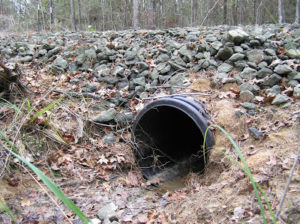Precision Pad Construction for Steady Foundations
Wiki Article
Accomplish Success With Culvert Installment: Best Practices Revealed
In this discussion, we will certainly explore crucial methods, tips, and guidelines that can considerably influence the outcome of culvert setups - Road construction. Understanding these essential elements is extremely important in making sure the architectural honesty and effectiveness of culverts, making it critical for professionals and lovers alike to grasp these fundamental principles.Correct Product Selection

Concrete culverts are understood for their toughness and longevity, making them ideal for rush hour areas and big water circulation volumes. Corrugated steel culverts are lightweight and easy to set up, excellent for temporary applications or scenarios requiring a fast remedy. Plastic culverts are light-weight, corrosion-resistant, and affordable, making them a popular selection for numerous culvert setups. Composite materials use a mix of residential or commercial properties from various materials, supplying a customizable option for particular task requirements. Ultimately, picking the correct material is important to ensure the culvert system functions successfully and has a lengthy life span.
Site Preparation Tips
Reliable site prep work is necessary for the effective setup of culverts, ensuring correct assimilation with the surrounding environment and lasting performance. Prior to starting the setup process, it is vital to perform an extensive website analysis to identify the suitable dimension, type, and positioning of the culvert. Cleaning the location of any particles, greenery, or obstructions is the primary step in site preparation. This makes sure a tidy and degree surface area for the culvert to be installed.Next, the dirt conditions need to be assessed to assess the security and load-bearing capacity of the ground. Depending on the dirt kind, additional measures such as compaction or support might be essential to stop resolving or moving of the culvert over time. Correct drainage considerations need to additionally be considered to stop water build-up around the culvert, which can bring about disintegration or architectural damage.
Finally, developing proper accessibility to the site for building devices and making certain compliance with any regulatory needs are crucial facets of website prep work. By adhering to these site prep work suggestions, the setup of culverts can be accomplished efficiently and effectively, promoting the longevity and functionality of the culvert system.
Setup Methods

To start with, it is vital to accurately gauge and note the location where the culvert will certainly be set up. This makes certain correct alignment and avoids any kind of errors during the setup stage. Second of all, excavation should be done very carefully to develop a steady foundation for the culvert. The trench needs to be dug to the correct depth and width, taking right into account the dimension and kind of culvert being mounted.
Next, the culvert should be placed in the trench adhering to the manufacturer's standards. Proper positioning is critical for the capability and durability of the culvert. Backfilling the trench with the ideal material and condensing it in layers is the last step in the installation process. This makes sure the culvert is firmly in position and ready to hold up against the demands it will face. By following these setup strategies faithfully, the culvert will be efficiently set up, adding to the total success of the job.
Maintenance Guidelines
After finishing the cautious setup of culverts following proper strategies, adherence to maintenance guidelines is vital to guarantee their durability and functionality. Normal examination is important to determine any type of indications of wear, obstructions, or architectural damage beforehand. Inspections need to consist of looking for sediment buildup, erosion around the culvert edges, and any kind Find Out More of indicators of corrosion or rust. Cleaning debris, such as branches or leaves, from the inlet and electrical outlet routinely is necessary to prevent blockages that can lead to flooding.In addition, preserving correct incline and placement of the culvert is important for reliable water flow and to avoid potential obstructing. Road construction. Any type of vegetation near the culvert must be taken care of to stay clear of origin breach and obstructions. In areas susceptible to freezing temperature levels, implementing winter upkeep techniques such as making certain appropriate drain to stop ice buildup is vital
Regular upkeep not just prolongs the lifespan of culverts yet also ensures they operate successfully in handling water circulation, reducing the threat of damages to facilities and bordering areas.
Troubleshooting Common Issues
Attending to common concerns that may emerge with culverts calls for a systematic method and careful analysis of the underlying causes. By examining the culvert alignment and incline routinely, prospective problems can be identified and dealt with without delay.
Final Thought
Finally, accomplishing success with culvert installation needs cautious factor to consider of see this material option, detailed site prep work, appropriate installation techniques, and regular maintenance. By following useful site finest practices and repairing typical concerns, the honesty and performance of culverts can be made certain. It is necessary to adhere to standards and recommendations to stop any possible problems and guarantee the durability of the culvert system.Report this wiki page